![]()
![]()
![]()
Use LEFT and RIGHT arrow keys to navigate between flashcards;
Use UP and DOWN arrow keys to flip the card;
H to show hint;
A reads text to speech;
73 Cards in this Set
- Front
- Back
|
What is connective tissue? |
One of the most abundant of the four basic tissue types in the body, performing the functions of binding and supporting; consists of relatively few cells in a generous matrix (the ground substance and fibers between the cells). |
|
|
The extracellular matrix consists of what? |
Protein fibres and ground substance. |
|
|
What are the main types of cells in connective tissue? |
1. Fibroblasts 2. Macrophages 3. Plasma Cells 4. Mast Cells 5. Adipocytes 6. Leukocytes |
|
|
What are fibroblasts? |
A large, flat cell that secretes most of the extracellular matrix of areolar and dense connective tissues. |
|
|
What are macrophages? |
Phagocytic cell derived from a monocyte; may be fixed or wandering. |
|
|
What are plasma cells? |
Cell that develops from a B cell (lymphocyte) and produces antibodies. |
|
|
What are mast cells? |
A cell found in areolar connective tissue that releases histamine, a dilator of small blood vessels, during inflammation. |
|
|
What are adipocytes? |
Fat cell, derived from a fibroblast. |
|
|
What are leukocytes? |
A white blood cell. |
|
|
What is the function of fibroblasts? |
Fibroblasts secrete fibers and ground substance of extracellular matrix. |
|
|
What are the three types of fibres embedded in the extracellular matrix? |
Collagen fibers, elastic fibers, and reticular fibers |
|
|
What types of polysaccharides are in the ground substance? What are they collectively referred to as? |
Hyaluronic acid, chondroitin sulfate, dermatan sulfate, and keratan sulfate. Collectively glycosaminoglycans (GAGs). |
|
|
Except for hyaluronic acid, that GAGs are associated with what? |
GAGs are associated with proteins called proteoglycans. |
|
|
What is one of the most important properties of GAGs? |
They trap water. |
|
|
What is hyaluronic acid and what does it do? |
A viscous, amorphous extracellular material that binds cells together, lubricates joints, and maintains the shape of the eyeballs.
|
|
|
What is chondroitin sulfate? |
An amorphous extracellular matrix material found outside connective tissue cells. |
|
|
What are the two types of embryonic connective tissue? |
Mesenchyme and mucous connective tissue. |
|
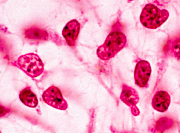
What type of tissue is this? |
Mesenchyme |
|
|
What is mesenchyme composed of? |
Irregularly shaped mesenchymal cells embedded in semifluid ground substance that contains delicate reticular fibers. |
|
|
Where would you find mesenchyme? |
Almost exclusively under skin and along developing bones of embryo; some in adult connective tissue, especially along blood vessels. |
|
|
What are the functions of mesenchyme? |
Forms almost all other types of connective tissue. |
|

What type of tissue is this? |
mucous connective tissue |
|
|
Where would you find mucous connective tissue? |
Umbilical cord of fetus. |
|
|
What are the functions of mucous connective tissue? |
Support. |
|
|
What is the second major subclass of connective tissue? |
mature connective tissue |
|
|
What are the five types of mature connective tissue? |
(1) loose connective tissue (2) dense connective tissue (3) cartilage (4) bone tissue (5) liquid connective tissue (blood and lymph) |
|
|
What are the three types of loose connective tissue? |
Areolar connective tissue, adipose tissue, reticular connective tissue. |
|
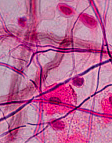
What type of tissue is this? |
areolar connective tissue |
|
|
Where would you find areolar connective tissue? |
In and around nearly every body structure (thus, called “packing material” of the body): in subcutaneous layer deep to skin; papillary (superficial) region of dermis of skin; lamina propria of mucous membranes; around blood vessels, nerves, and body organs. |
|
|
What are the functions of areolar connective tissue? |
Strength, elasticity, support. |
|
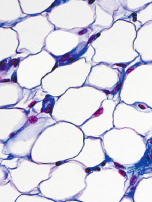
What type of tissue is this? |
adipose tissue |
|
|
Where would you find adipose tissue? |
Wherever areolar connective tissue is located: subcutaneous layer deep to skin, around heart and kidneys, yellow bone marrow, padding around joints and behind eyeball in eye socket. |
|
|
What are the functions of adipose tissue? |
Reduces heat loss through skin; serves as an energy reserve; supports and protects organs. In newborns, BAT generates heat to maintain proper body temperature. |
|
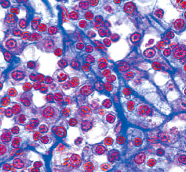
What type of tissue is this? |
reticular connective tissue |
|
|
Where would you find reticular connective tissue? |
Stroma (supporting framework) of liver, spleen, lymph nodes; red bone marrow; reticular lamina of basement membrane; around blood vessels and muscles. |
|
|
What are the functions of reticular connective tissue? |
Forms stroma of organs; binds smooth muscle tissue cells; filters and removes worn-out blood cells in spleen and microbes in lymph nodes. |
|
|
What are the three types of dense connective tissue? |
dense regular connective tissue, dense irregular connective tissue, and elastic connective tissue |
|
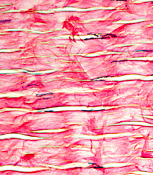
What type of tissue is this? |
dense regular connective tissue |
|
|
Where would you find dense regular connective tissue? |
Forms tendons (attach muscle to bone), most ligaments (attach bone to bone), and aponeuroses (sheetlike tendons that attach muscle to muscle or muscle to bone). |
|
|
What are the functions of dense regular connective tissue? |
Provides strong attachment between various structures. Tissue structure withstands pulling (tension) along long axis of fibers. |
|
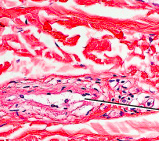
What type of tissue is this? |
dense irregular connective tissue |
|
|
Where would you find dense irregular connective tissue? |
Often occurs in sheets, such as fasciae (tissue beneath skin and around muscles and other organs), reticular (deeper) region of dermis of skin, fibrous pericardium of heart, periosteum of bone, perichondrium of cartilage, joint capsules, membrane capsules around various organs (kidneys, liver, testes, lymph nodes); also in heart valves. |
|
|
What are the functions of dense irregular connective tissue? |
Provides tensile (pulling) strength in many directions. |
|

What type of tissue is this? |
elastic connective tissue |
|
|
Where would you find elastic connective tissue? |
Lung tissue, walls of elastic arteries, trachea, bronchial tubes, true vocal cords, suspensory ligaments of penis, some ligaments between vertebrae. |
|
|
What are the functions of elastic connective tissue? |
Allows stretching of various organs; is strong and can recoil to original shape after being stretched. Elasticity is important to normal functioning of lung tissue (recoils in exhaling) and elastic arteries (recoil between heartbeats to help maintain blood flow). |
|
|
What are the three types of cartilage? |
hyaline cartilage, fibrocartilage, and elastic cartilage |
|

What type of tissue is this? |
hyaline cartilage |
|
|
Where would you find hyaline cartilage? |
Most abundant cartilage in body; at ends of long bones, anterior ends of ribs, nose, parts of larynx, trachea, bronchi, bronchial tubes, embryonic and fetal skeleton. |
|
|
What are the functions of hyaline cartilage? |
Provides smooth surfaces for movement at joints, flexibility, and support; weakest type of cartilage and can be fractured. |
|
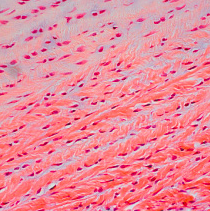
What type of cartilage is this? |
fibrocartilage |
|
|
Where would you find fibrocartilage? |
Pubic symphysis (where hip bones join anteriorly), intervertebral discs, menisci (cartilage pads) of knee, portions of tendons that insert into cartilage. |
|
|
What are the functions of fibrocartilage? |
Support and joining structures together. Strength and rigidity make it the strongest type of cartilage. |
|
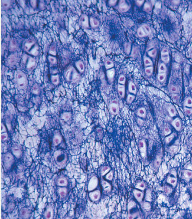
What type of tissue is this? |
elastic cartilage |
|
|
Where would you find elastic cartilage? |
Lid on top of larynx (epiglottis), part of external ear (auricle), auditory (eustachian) tubes. |
|
|
What are the functions of elastic cartilage? |
Provides strength and elasticity; maintains shape of certain structures. |
|
|
What is a chondrocyte? |
Cell of mature cartilage. |
|
|
What is a lacunae? |
A small, hollow space, such as that found in bones in which the osteocytes lie. Singular is lacuna (la-KOO-na). |
|
|
What is the perichondrium? |
The membrane that covers cartilage. |
|
|
What is interstitial growth? |
Growth from within, as in the growth of cartilage. |
|
|
What is appositional growth? |
Growth due to surface deposition of material, as in the growth in diameter of cartilage and bone. |
|
|
What is the basic unit of compact bone? |
Osteon. Also called a haversian system. |
|
|
What are the four parts of each osteon? |
Haversian canal, lamellae, lacunae, osteocytes, and canaliculi. |
|
|
What are lamellae? |
Concentric rings of hard, calcified extracellular matrix found in compact bone. |
|
|
What is an osteocyte? |
A mature bone cell that maintains the daily activities of bone tissue. |
|
|
What are canaliculi? |
A small channel or canal, as in bones, where they connect lacunae. Singular is called canaliculus. |
|
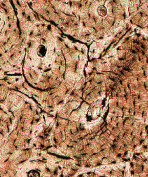
What type of tissue is this? |
bone tissue |
|
|
Where would you find bone tissue? |
Both compact and spongy bone tissue make up the various parts of bones of the body. |
|
|
What are the functions of bone tissue? |
Support, protection, storage; houses blood-forming tissue; serves as levers that act with muscle tissue to enable movement. |
|
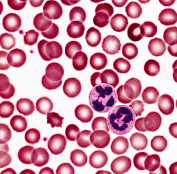
What type of tissue is this? |
blood tissue |
|
|
Where would you find blood plasma? |
Within blood vessels (arteries, arterioles, capillaries, venules, veins), within chambers of heart. |
|
|
What are the functions of blood plasma? |
Red blood cells: transport oxygen and some carbon dioxide; white blood cells: carry on phagocytosis and mediate allergic reactions and immune system responses; platelets: essential for blood clotting. |
|
|
What is lymph? |
Fluid confined in lymphatic vessels and flowing through the lymphatic system until it is returned to the blood. |

